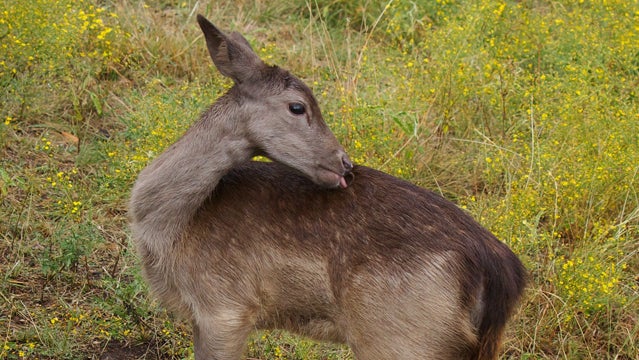With an estimated 30 million deer in the United States alone, and the ever increasing emphasis on locavore eating ethics, it’s time you traded in that Patagonia catalogue for ’s and started learning how to provide on a whole new level.
Field Dress
Not only does field dressing make lugging your deer back to the truck way more manageable, it also is critical to preserving the meat. First, prop the deer belly up against a rock or tree, positioning the head higher than the body. Snap on a pair of rubber gloves, keep your bear spray handy and pull out a sharp four-inch blade. “Be damn careful,” says Wyoming native Tyrel “Tex” Mack whose been hunting since he could walk. “This is where hunters slice femoral arteries.”
With the knife oriented towards the sky, slice a two-inch deep opening from right above the deer’s nether reaches all the way up to the bottom of the ribcage. Roll the deer on its side and let gravity do the dirty work of spilling out the organs then clean up with a few careful cuts of connective tissue. Next, carve out the diaphragm, the muscle situated below the heart and lungs and above the intestines. Find the esophagus, a tube hanging out between the heart and the lungs. Grab the esophagus right above the heart and make a cut just above. With the diaphragm and esophagus out of the way, the rest of the organs are ready for removal. Don’t forget you can eat some organs (liver, heart are tasty, kidneys tend to be a little strong.
Remember, depending on what kind of land you’re hunting you may be required to dispose of your gut pile—a major wildlife attractant and riddled with problems related to the use of lead bullets (which you shouldn’t be using anyways.)
Skin
Back at the ranch, lasso the deer by the neck, and suspend it at head height in a spot that’s cool, safe from critters, and where you can let it hang for a few days to cure without freaking anybody out. After two to four days, it’s time to start cleaning. Cut all the way around the deer’s neckline, intersecting with the earlier cut used to splay the deer open. Begin peeling the hide away from the body, using your knife to cut at the fascia. Once you’ve peeled the hide back to the shoulders, use some cutting and twisting to remove the forelegs just above the knee joints. Make a cut running from the insides of the deer’s hind legs to the intersection with the initial slice made in the field. Continue working the hide off the body, until you reach the tailbone. Cut through the tailbone and keep pulling the hide off until reaching the dark, inner thigh patches marking the tarsal glands. Cut the hind legs off right above the glands.
Process
First head to the library for the butchering bible, complete with 130 illustrations. Then stop at the grocery store for freezer paper. Invite a few friends over for dinner, the caveat being they’ve got to help harvest. Otherwise expect to spend the rest of the day alone in your garage reeking of meat. Start with the front legs for roasts and stew work your way down the body making sure to grab the back straps and tenderloin as you work your way down the ribcage. White lines of connective tissue help guide your cuts and you’ll quickly find yourself surprised by how easy it is to follow the bodies of muscle if you let a little intuition sneak into the process. Trim off any unwanted bits and pack it up in a piece of freezer paper. Last, drag out the meat grinder and use all the random bits for burgers you can throw right on the grill as promised to your sous chefs.


